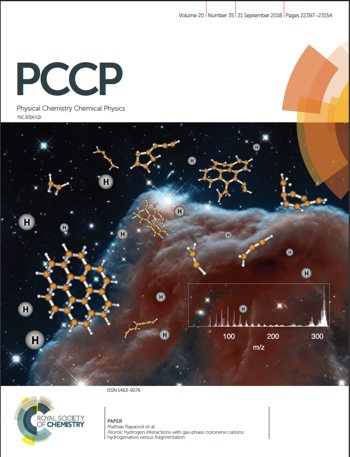Work of Thomas Schlathölter and his team featured on PCCP cover

Sequential attachment of atomic hydrogen to polycyclic aromatic hydrocarbon (PAH) molecules such as coronene leads to a gradual transition from an aromatic to an aliphatic molecular electronic structure. At the same time, the planar PAH geometry breaks down and is gradually replaced by a corrugated structure. The process is very similar to hydrogenation of graphene sheets, which can be employed to open up the graphene band gap in a controlled way. Furthermore, interactions of atomic hydrogen with PAHs are considered relevant for formation H2 formation in the interstellar medium.
In a collaboration between theory (M. Rapacioli and Aude Simon, Toulouse, France), astronomy ( S. Cazaux , Delft) and experiment (N. Foley, R. Hoekstra, T. Schlathölter, ZIAM) this hydrogenation process for the model PAH cation coronene was thoroughly studied. The study established how the balance between energy deposition by hydrogen attachment and the extent of cooling between subsequent attachment events manifests in mass spectra dominated by small hydrocarbon fragment cation and multiply hydrogenated coronene cations.
"Atomic hydrogen interactions with gas-phase coronene cations: hydrogenation versus fragmentation" Mathias Rapacioli, Stéphanie Cazaux, Nolan Foley, Aude Simon, Ronnie Hoekstra and Thomas Schlathölter, Physical Chemistry Chemical Physics, Vol 20 (35) 21 September 2018 https://pubs.rsc.org/en/content/articlelanding/2018/cp/c8cp03024c#!divAbstract
For more information please contact Thomas Schlathölter
| Last modified: | 02 October 2018 09.36 a.m. |
More news
-
04 July 2025
University of Groningen awards various prizes during Ceremony of Merits
The UG awarded different prizes to excellent researchers and students during the Ceremony of Merits on 4 July 2025.
-
02 July 2025
Relinde Weil reappointed as a member of the Supervisory Board UG
The Minister of Education has reappointed Relinde Weil for a second term as a member of the Supervisory Board of the University of Groningen.
